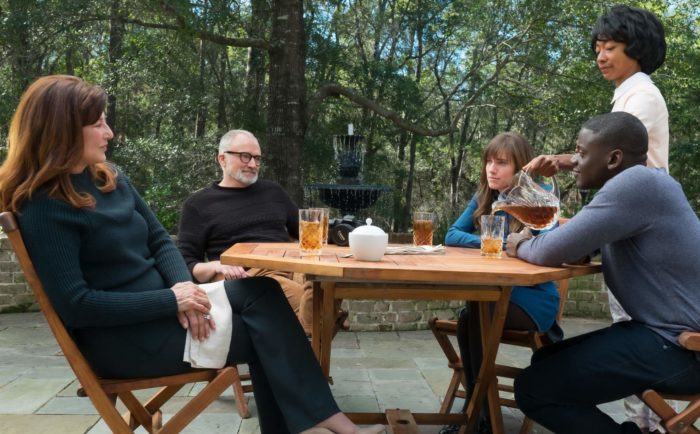The line between comedy and horror is tightrope thin, and sketch star Jordan Peele’s directorial debut is a nimble balancing act atop a live wire. Charged with a current of social commentary, Get Out surges along the circuits of genre convention — only to abruptly about-face, jolting the audience into frequent, giddy chaos. Emblematic of these narrative left turns is the scene that spawned the #GetOutChallenge meme, in which a character sprints homicidally toward the screen, then jukes at the last possible second. The moment perfectly encapsulates Peele’s mischievous M.O.
Right from the get-go, the filmmaker seeks to upend audience assumptions with a prologue that paints the suburbs as an unwelcoming and unsafe place — at least for an adolescent black guy. In the uncertain aftermath of this warning salvo, we’re introduced to our introspective protagonist, photog Chris Washington (Daniel Kaluuya) and his Caucasian girlfriend, Rose (Allison Williams of Girls fame). At her invitation, Chris reluctantly commits to spend a weekend in bucolic (strike that — waspy) upstate New York with her well-to-do parents (cue a very game Catherine Keener and Bradley Whitford).

But what begins as a recipe for awkward comedy unfurls as a portentous mystery, with beguiling hints of malice that mount and mount until the film topples into its bloody, raucous third act. Peele deploys comic ballast in the form of Chris’ confidant Rob (Lil Rel Howery): temporary apartment-sitter, TSA agent, and one-man Greek chorus. As Chris relays each inscrutable encounter over the phone, Rob becomes the voice of the audience’s increasing anxiety. These lighthearted interactions keep Get Out from becoming overly comfortable in the cobwebbed entrapments of the genre and help shepherd the film safely past the pitfalls of self-seriousness.
A healthy sense of humor proves Peele’s strongest asset as a filmmaker. Like all great comedians, he’s keenly aware of when and how far he can push his audience, and that talent translates into surprisingly strong narrative instincts and an impressive command of tone. Though Get Out rarely wows in the visual department, one sequence stands out as an exception to the rule—one that exemplifies the director’s willingness to dig Under the Skin, to borrow a title to go along with the borrowed motif.
It’s the middle of the night and Chris, having slipped out to sneak a cigarette, returns to find Keener’s character — a therapist—awake in her study. She offers to hypnotize Chris to help him kick his smoking habit while not-so-subtly plying him for information about his past. Peele conveys the gradual erosion of mental resistance through the repetition of an unnerving and oppressive audio cue; before Chris knows it, he’s in over his head in the black ocean of own subconscious. The realization of this abstract, psychological hell, though familiar, is one of the film’s few genuinely awesome and arresting visuals.
Horror, like comedy, relies on maintaining a sense of the unexpected, and Get Out goes above and beyond to keep its audience guessing. Delivered with a defiant wink by a director with a unique knack for social commentary, the film slyly subverts expectation without compromising on entertainment. This darkly absurd and vitally relevant American hypothetical follows in the footsteps of socially conscious genre greats like Night of the Living Dead — but beyond its woke thrills, perhaps what’s most shocking is how little has changed in the 50 years since George Romero radically redefined the face of terror.